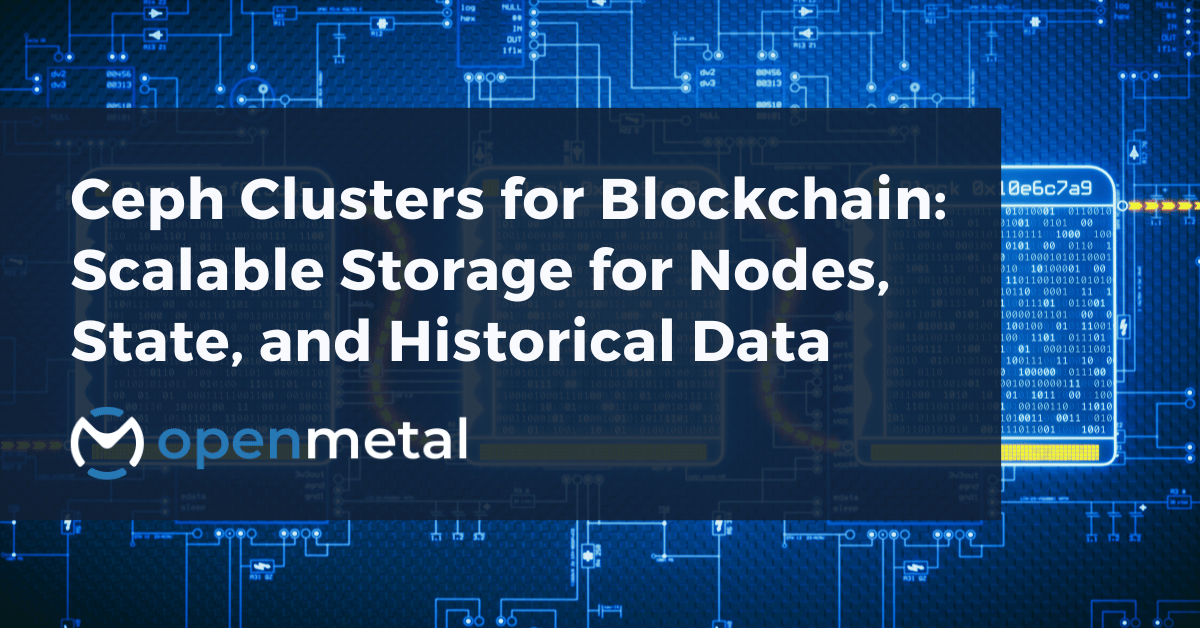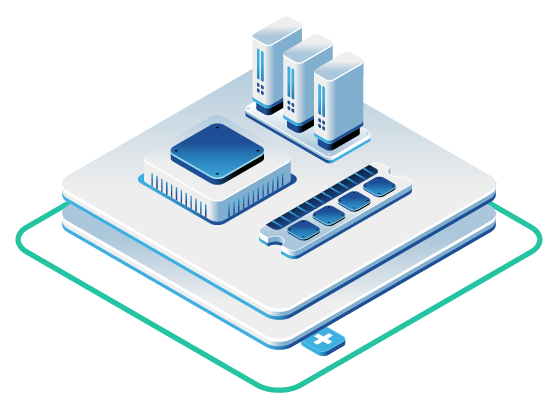
If you’re running blockchain infrastructure, storage isn’t just about capacity—it’s about handling massive state databases, validator requirements, and terabytes of historical data that grows every day. Traditional cloud storage often hits you with unpredictable bills and performance bottlenecks just when your nodes need it most.
Ceph distributed storage offers a different approach. Instead of relying on third-party storage services that charge per operation, you get a unified system that scales with your blockchain workload while maintaining the performance consistency validator nodes demand.
What Makes Blockchain Storage Different
Running blockchain nodes creates unique storage challenges that standard enterprise storage wasn’t designed to handle. Understanding these requirements helps explain why teams are moving toward distributed storage solutions like Ceph.
Validator Node Requirements
Modern validator nodes require robust hardware configurations, including 32 GB DDR4 RAM minimum and 4 TB SSD storage with NVMe recommended for optimal performance. But storage needs go beyond raw capacity.
Validator nodes handle constant read-write operations as they process transactions, update state databases, and participate in consensus. Unlike traditional applications that might have predictable I/O patterns, blockchain validators deal with unpredictable transaction volumes and state changes that can spike storage demands.
The consensus process requires validators to maintain the current blockchain state while quickly accessing recent transaction history. This means storage systems need both high throughput for current operations and low-latency access to recent blocks.
Archive Node Storage Demands
Archive nodes present an entirely different challenge. Currently, storage needed for running an Archive node is around ~12 TB on Geth and ~2 TB on Erigon, and this will grow over time. These nodes store complete blockchain history, making them essential for applications requiring historical data access.
Because archival nodes store the entire history of the blockchain, the database size on archival nodes will continue to grow unbounded. This creates a storage scaling challenge that traditional storage solutions struggle to address cost-effectively.
For teams running full blockchain infrastructure, this means planning for storage that grows continuously without hitting cost or performance walls. Archive nodes might start at 12TB but could reach 20TB+ within a year, depending on network activity.
For privacy-focused blockchain applications, this storage challenge becomes even more complex when you need to maintain confidentiality while scaling. Teams building privacy-centric blockchain apps often require specialized infrastructure that can handle both storage scaling and security requirements.
State Database Growth
Blockchain state databases track account balances, smart contract storage, and other network state information. Unlike transaction logs, state data requires frequent updates and immediate access during block validation.
State databases can experience rapid growth during periods of high network activity. DeFi applications, NFT trading, and other smart contract interactions all contribute to state bloat, requiring storage systems that can handle both growth and maintain consistent performance.
Understanding Ceph for Blockchain Workloads
Ceph provides an infinitely scalable Ceph Storage Cluster based upon RADOS, a reliable, distributed storage service that uses the intelligence in each of its nodes to secure the data it stores and to provide that data to clients.
For blockchain infrastructure, this distributed approach solves several critical problems that traditional storage can’t address effectively.
How Ceph’s Architecture Benefits Blockchain
Ceph Clients and Ceph OSD Daemons both use the CRUSH algorithm to compute information about object location instead of relying upon a central lookup table. This means your blockchain nodes can access data without bottlenecks from centralized storage controllers.
The distributed nature of Ceph aligns well with blockchain’s distributed architecture. Instead of having storage as a potential single point of failure, Ceph spreads data across multiple nodes with automatic replication, ensuring your validator or archive nodes can continue operating even if storage hardware fails.
Ceph implements distributed object storage and provides distributed operation without a single point of failure and scalability. For blockchain teams, this translates to storage infrastructure that matches the resilience requirements of the blockchain networks they’re supporting.
Storage Types for Different Blockchain Needs
Ceph offers three storage interfaces that map well to different blockchain use cases:
Object Storage (RGW) works well for archival data, blockchain snapshots, and backup systems. Teams can store compressed blockchain history or state snapshots using S3-compatible APIs, making it easy to integrate with existing backup workflows.
Block Storage (RBD) provides the high-performance storage that validator nodes need for state databases and transaction processing. Significant write performance occurs when the client writes the stripe units to their corresponding objects in parallel.
File Storage (CephFS) can handle logs, configuration files, and shared data that multiple blockchain nodes might need to access simultaneously.
Scaling Without Disruption
If you anticipate large images sizes, large S3 or Swift objects (e.g., video), or large CephFS directories, you may see considerable read/write performance improvements by stripping client data over multiple objects within an object set.
For blockchain workloads, this means archive nodes storing large historical datasets can benefit from automatic data striping across multiple storage devices, improving both read performance and write throughput.
When you need to add storage capacity, Ceph handles the data rebalancing automatically. New storage nodes join the cluster and begin handling their share of data without requiring downtime or manual intervention.
OpenMetal’s Ceph Implementation for Blockchain
OpenMetal integrates Ceph as a standard part of every private cloud deployment, but the implementation is specifically designed to handle the demands of storage-intensive workloads like blockchain infrastructure.
Hardware Optimized for Blockchain Storage
OpenMetal’s Ceph storage clusters run on bare metal dedicated servers with dual Intel Xeon CPUs, 192 GB RAM, and Micron 7500 NVMe drives. This hardware combination addresses the specific performance characteristics blockchain workloads require.
The 192 GB RAM provides substantial caching capacity, which helps with the random read patterns common in blockchain state access. When validator nodes query recent state data or archive nodes serve historical information, much of that data can be served from memory rather than requiring disk access.
Micron 7500 NVMe drives deliver the low-latency, high-throughput storage that validator nodes need for state database operations. These drives can handle the mixed read-write workloads that occur when nodes are processing transactions while serving data requests.
Network Architecture for Storage Traffic
Each server includes dual 10 Gbps links, providing 20 Gbps total bandwidth for storage operations. More importantly, internal east-west traffic like Ceph replication is unmetered, addressing a major cost concern for blockchain teams.
Blockchain storage generates significant internal traffic between nodes. State synchronization, block replication, and consensus communication all create network overhead that public cloud providers typically charge for as data egress.
With unmetered internal traffic, blockchain teams can implement proper redundancy and backup strategies without worrying about unexpected network charges. Archive nodes can replicate historical data across multiple locations, and validator nodes can maintain state backups without hitting bandwidth caps.
Predictable Scaling and Costs
Because Ceph is embedded into OpenMetal Cloud Cores, storage nodes can be added in around 20 minutes, and the cluster automatically rebalances. This rapid scaling capability is particularly important for blockchain workloads that can experience sudden growth.
During network congestion periods or major protocol upgrades, blockchain storage requirements can spike quickly. Traditional storage solutions might require lengthy provisioning processes or force teams to over-provision storage “just in case.”
With OpenMetal’s approach, teams can add storage capacity when they need it and trust that the system will integrate new resources without disrupting running blockchain nodes. The cluster handles data migration and load balancing automatically.
Cost Advantages for Blockchain Teams
Combined with OpenMetal’s fixed monthly pricing, blockchain operators avoid the unpredictable egress and per-operation fees common in public cloud, often saving 30–60%.
This cost predictability becomes particularly valuable for archive nodes, which require terabytes of historical transaction data to remain accessible at low latency. Public cloud storage for this use case often involves expensive “hot” storage tiers to maintain performance, with additional charges for data retrieval.
OpenMetal’s fixed pricing model means teams can plan their infrastructure costs accurately, even as their storage requirements grow. There are no surprise bills when archive nodes need to serve large amounts of historical data or when validator nodes increase their transaction processing activity.
Real-World Implementation: Web3 Storage Protocol
A Web3 team building a decentralized storage and data availability protocol needed an infrastructure partner that could deliver low-cost, high-throughput storage without sacrificing flexibility.
This case study demonstrates how Ceph clusters address real blockchain storage challenges beyond theoretical benefits.
The Infrastructure Challenge
The team behind the decentralized storage protocol needed a cost-effective way to build and scale blockchain infrastructure on bare metal and Ceph storage that could handle large binary datasets (‘blobs’) of data across a distributed network.
Their protocol required storing and serving large data blobs while maintaining the performance and redundancy characteristics that Web3 applications demand. Traditional cloud storage solutions were either too expensive or didn’t provide the control needed for their distributed architecture.
Ceph Cluster Configuration
To support their storage layer, the team deployed a cluster of five OpenMetal Ceph-based storage servers: Four Large v3 storage servers: Intel Xeon Silver 4314, 256GB RAM, 216TB HDD, 1.6TB NVMe SSD – One Large v1 storage server: Intel Xeon Silver 4210R, 128GB RAM, 144TB HDD, 4TB NVMe SSD.
This configuration demonstrates a key Ceph advantage: mixing storage types within the same cluster. The NVMe tier supports rapid blob access and indexing while the HDDs handle durable, large-scale blob persistence.
For blockchain workloads, this tiered approach allows teams to optimize costs while maintaining performance. Frequently accessed data like recent state information can live on NVMe storage, while historical archives can use higher-capacity, lower-cost spinning drives.
Performance and Cost Results
With 256GB of RAM, each node had enough memory to support large write buffers and caching layers that improve cluster responsiveness under load. The team achieved their cost targets while maintaining the performance characteristics their protocol required.
The implementation delivered cost-per-terabyte savings compared to their previous infrastructure while providing better control over data placement and access patterns. This combination of cost efficiency and performance control is particularly valuable for blockchain teams building infrastructure that needs to scale economically.
Storage Strategies for Different Node Types
Different blockchain node types have distinct storage requirements that Ceph’s flexible architecture can address through appropriate configuration and hardware selection.
Validator Node Storage Configuration
Validator nodes prioritize performance and reliability over capacity. They need fast access to current state data and recent transaction history, but typically don’t store extensive historical information.
For validator nodes, configuring Ceph with NVMe-backed pools provides the low-latency storage required for state database operations. The automatic replication ensures validator uptime even if individual storage devices fail.
Memory caching becomes particularly important for validator nodes. With sufficient RAM allocated to Ceph’s cache layers, frequently accessed state data stays in memory, reducing the storage I/O load during busy transaction processing periods.
Archive Node Storage Strategy
Archive nodes will maintain the blockchain’s historical data/states and may earn a portion of the network reward as an incentive to store historical data.
Archive nodes require massive storage capacity with predictable cost scaling. Ceph’s ability to mix storage types within the same cluster allows archive nodes to use cost-effective HDD storage for bulk historical data while maintaining NVMe storage for indices and recently accessed information.
The automatic tiering capabilities in modern Ceph deployments can move frequently accessed historical data to faster storage automatically, optimizing both performance and costs without manual intervention.
Full Node Balanced Approach
Full nodes need to balance storage capacity, performance, and cost. They maintain recent blockchain history and current state but don’t require the massive capacity of archive nodes or the extreme performance focus of validators.
Ceph’s flexible pool configuration allows full nodes to use mixed storage approaches. Critical state data can use high-performance pools while transaction history uses capacity-optimized storage, all within the same cluster.
Customization and Performance Optimization
OpenMetal allows customizations, such as adding more RAM or expanding NVMe storage, so blockchain workloads can handle state growth or compaction more effectively.
For teams requiring additional security measures, OpenMetal also supports Intel TDX performance optimization for confidential blockchain workloads that need to protect sensitive data during processing.
Memory Optimization for Blockchain Workloads
Blockchain storage access patterns differ significantly from traditional enterprise applications. State databases have hot spots where certain accounts or contracts see frequent access, while historical data has more predictable access patterns.
Additional RAM allows Ceph to cache more data, reducing storage I/O for frequently accessed blockchain state. For validator nodes processing transactions, this can significantly improve response times during network congestion periods.
The caching also helps with read-heavy workloads like serving blockchain data to applications or handling RPC requests. More cache means better performance for these secondary workloads without impacting primary validation tasks.
NVMe Expansion for Growing State
State database growth is one of the biggest challenges facing blockchain networks. As networks mature and see increased smart contract usage, state databases can grow rapidly and unpredictably.
OpenMetal’s ability to expand NVMe storage provides a path for handling state growth without requiring infrastructure redesign. Teams can start with appropriate storage for current needs and expand as requirements grow.
The expansion process integrates with Ceph’s automatic rebalancing, so new storage capacity becomes available without downtime or manual data migration tasks.
Performance Tuning for Specific Protocols
Different blockchain protocols have different I/O characteristics. Some prioritize transaction throughput, others focus on state query performance, and some need to balance both with archival capabilities.
Ceph’s tunable parameters allow optimization for specific protocol requirements. Pool configurations can be adjusted for read-heavy archive access, write-heavy validator operations, or mixed workloads that full nodes typically handle.
This tuning capability means blockchain teams can optimize their storage for their specific protocol rather than accepting generic storage configurations that may not align with their performance requirements.
Planning Your Blockchain Storage Architecture
Implementing Ceph for blockchain storage requires understanding your specific requirements and growth projections. Different blockchain networks and use cases will have varying storage needs that should inform your architecture decisions.
Capacity Planning Considerations
Start by understanding your blockchain’s storage growth patterns. Archive node storage around ~12 TB on Geth and ~2 TB on Erigon will grow over time, but the growth rate varies significantly between different blockchain networks.
High-activity networks like Ethereum see steady state growth from smart contract interactions, while newer networks might experience more variable growth patterns. Plan for both steady growth and potential spikes during network congestion or major protocol events.
Consider the storage requirements for different node types you plan to run. A mixed infrastructure with validators, full nodes, and archive nodes will have different storage profiles that Ceph can address through pool configuration and hardware allocation.
Network and Bandwidth Requirements
A stable, high-bandwidth network connection is crucial for timely communication between nodes. This applies not just to blockchain peer-to-peer communication but also to storage cluster communication.
Ceph’s replication traffic can be substantial, particularly during initial synchronization or when adding new storage nodes. OpenMetal’s unmetered internal traffic eliminates cost concerns, but bandwidth planning still matters for performance.
Plan for both east-west traffic within the storage cluster and north-south traffic between blockchain nodes and storage. Archive nodes serving historical data can generate significant egress traffic that needs adequate network capacity.
Redundancy and Backup Strategies
Blockchain infrastructure requires high availability, but the specific redundancy requirements vary based on node type and network participation requirements.
Validator nodes typically need immediate failover capabilities to avoid missing consensus participation windows. Ceph’s replication can provide this, but consider whether additional backup strategies are needed for validator-specific data like signing keys.
Archive nodes can tolerate longer recovery times but need reliable data preservation. Ceph’s erasure coding options can provide efficient redundancy for large historical datasets without the overhead of full replication.
Getting Started with Ceph Blockchain Storage
Moving to Ceph-based storage for blockchain infrastructure requires planning the migration, configuring appropriate performance parameters, and integrating with existing blockchain node operations.
Initial Deployment Considerations
Start with understanding your current storage utilization patterns. Monitor existing blockchain nodes to understand their I/O patterns, capacity requirements, and performance bottlenecks before designing your Ceph implementation.
Consider starting with a subset of your blockchain infrastructure to validate performance and operational procedures. Archive nodes often make good candidates for initial Ceph deployment since they’re typically less sensitive to storage performance variations during migration.
Plan for data migration strategies that minimize downtime for active validator nodes. Ceph’s ability to add and remove storage pools provides flexibility for gradual migration approaches.
Performance Validation
Before moving production blockchain workloads to Ceph storage, validate that the configuration meets your performance requirements under realistic load conditions.
Test with your specific blockchain client software and typical workloads. Different blockchain clients have varying storage access patterns, and some may benefit from specific Ceph tuning parameters.
Validate both normal operation performance and recovery scenarios. Blockchain networks can experience sudden load spikes or require rapid state access during network reorganizations.
Operational Integration
Integrate Ceph monitoring with your existing blockchain infrastructure monitoring. Storage performance issues can cascade to blockchain node performance, so coordinated monitoring helps identify problems early.
Develop operational procedures for storage maintenance that consider blockchain node requirements. Some maintenance tasks might require coordination with validator node operations to avoid consensus participation issues.
Plan for capacity expansion procedures that align with blockchain growth patterns. Automated monitoring can help predict when additional storage capacity will be needed based on blockchain network activity.
Wrapping It Up
Storage infrastructure might not get the attention that consensus algorithms or tokenomics receive, but it’s foundational to reliable blockchain operations. As networks mature and data requirements grow, the storage decisions you make today will determine whether your infrastructure can scale economically.
Ceph distributed storage provides a path forward that aligns with blockchain architecture principles: distributed, resilient, and scalable without central points of failure. Combined with OpenMetal’s bare metal implementation, you get the performance consistency and cost predictability that blockchain infrastructure demands.
Whether you’re running validator nodes, archive nodes, or mixed blockchain infrastructure, the storage foundation matters more than teams often realize. With the right distributed storage approach, you can focus on blockchain innovation rather than storage limitations.
This storage-first approach benefits not just blockchain-specific use cases, but also SaaS applications that are integrating blockchain functionality and need reliable, scalable infrastructure to support their growing data requirements.
Ready to deploy blockchain infrastructure on Ceph storage? Contact OpenMetal to explore our bare metal and private cloud solutions for blockchain applications.
Read More on the OpenMetal Blog


































